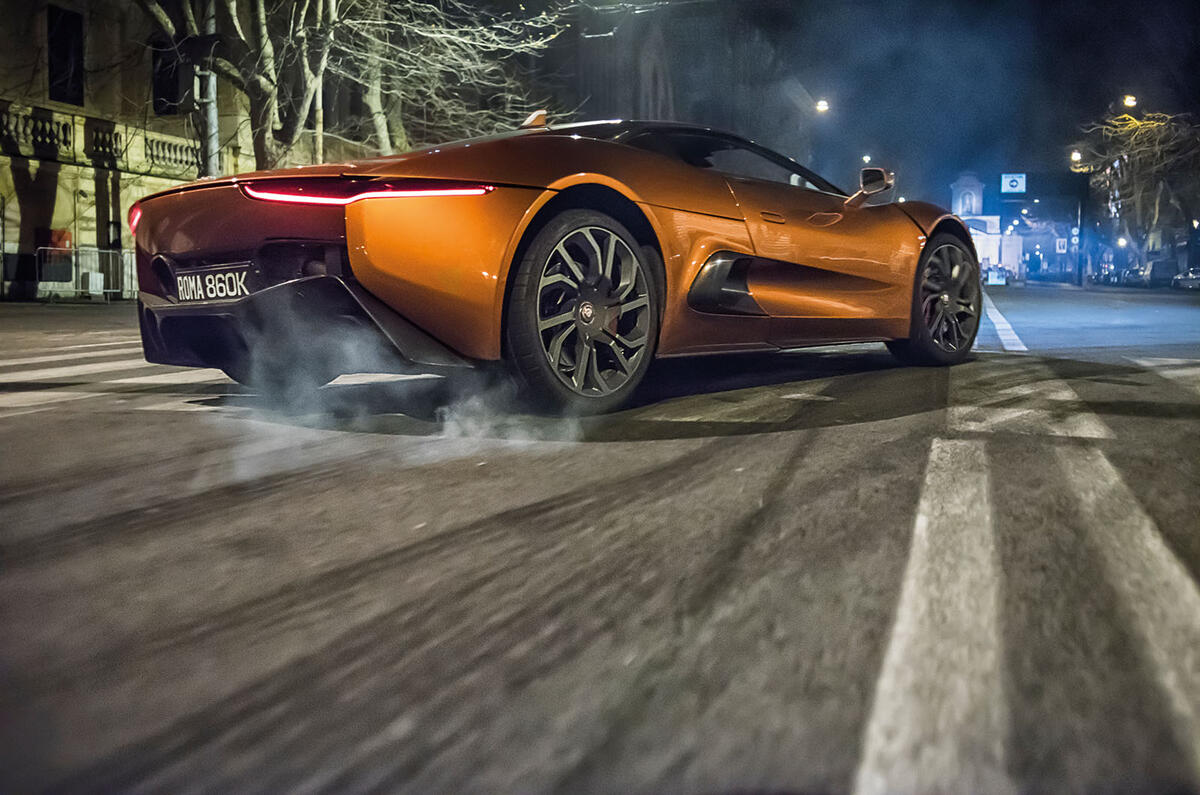Remember the Jaguar C-X75? Of course you do. Created for Jaguar’s 75th anniversary, it was revealed to much fanfare back in 2010 at the Paris motor show. It was eventually confirmed for production in 2011, albeit with a hybrid drivetrain simpler than the innovative micro turbine one first seen in the original concept.
By December 2012 Jaguar had spiked the car completely, the C-X75 officially a victim of the global financial crisis and unofficially too much of a distraction to put into production at a time when development was ramping up of the crucial next-generation of models we’re now seeing, with the Jaguar XE, XF and F-Pace.
However, then the producers of the James Bond franchise picked up the phone. Jaguar Land Rover has a strong relationship with Eon Productions, something that has continued with the latest movie Spectre. Bond himself had his own car sorted with the Aston Martin DB10, but the producers wanted a supercar for the villain. Jaguar had the C-X75.
“The C-X75 is in the film because they wanted a supercar for the villain,” John Edwards, head of Jaguar Land Rover’s Special Vehicle Operations division, told me at the Frankfurt show.
“We thought, why not? There wasn’t much persuading. It was an opportunity to showcase it, but it doesn’t mean a change in strategy. The decision has been made [not to make it] and we can hold our heads up high on that.”
That last bit is key: Jaguar still will not be making the C-X75 for public consumption, no matter how nicely you ask. But tantalisingly, that doesn’t make it hasn’t been looked at again in the meantime.
Jaguar is understood to have considered rebooting the C-X75 again this year in a limited production run (80 units or so) to mark its 80th anniversary and its appearance in the new Bond film, possibly even with a new C-X80 name. But the idea never got off the ground, the car being considered too old and it again being a distraction to the core new model launches.
Edwards concedes that “some people thought it shouldn’t have been spiked in the first place”, but neither that nor the car’s appearance in Bond means that Jaguar will reconsider. Indeed, the C-X75 is now a five-year-old design.
The questions on the C-X75 making a more permanent comeback were inevitable the moment it was confirmed for Bond. On that subject Edwards said: “We know what we’re doing, and that we’ll get a reaction, and [questions on] the relevance. There’s not a nervousness.”
The whispers then increased over the summer that the C-X75 was not dead yet and would be built, and to an extent that is true because seven cars were made for the film (which is probably where the whispers of it being made came from); five stunt models that are now in various states of disrepair and two ‘hero’ cars that Jaguar will keep, each model being powered by a 542bhp 5.0-litre supercharged V8 engine. But that’s your lot.
Jaguar has no plans to sell either [of the two 'hero' cars] of them off, unlike as fellow Gaydon resident Aston is doing with one example of the DB10 heading to auction.
The C-X75, then, was just never meant to be.




Join the debate
Add your comment
#4
Just a real shame they didn't follow through, and I think it's indicative of their conservative mindset. The X75 would have been genuinely pioneering, in a way that Jaguar *used* to be during their pinnacle, but hasn't really managed since the 2003 XJ, or arguably even the XJ220.
What *has* been seeing the light of day are 'me too' cars like the Macan aping F-pace and 3-series aping XE, with repetitive, derivative and increasingly unexceptional styling. You always hear Jaguar compared with the "German giants" in motoring magazines, it pisses me off, but maybe it's a notion the company invites by only following the same footsteps.
@Vertigo
#2
Concerns over whether the car would sell with a Jaguar badge *might* have had some effect, with the XJ220 being their last attempt, but it's unlikely to be the whole reason. The whole point of a volume manufacturer developing a supercar is to CREATE a stronger brand image, enabling them to sell more of its profitable models.
The most likely scenario I heard floated around at the time was about its drivetrain. The concept's turbine technology wasn't expected to be road-ready before 2018, but even the substitute system planned for production was radically advanced. Hybrid, AND turbocharged, AND supercharged, AND direct injection, AND extremely high-revving.
Supposedly, either they were having problems making the system reliable enough for production, or it was going to be so complex that every car would cost a fortune to make.